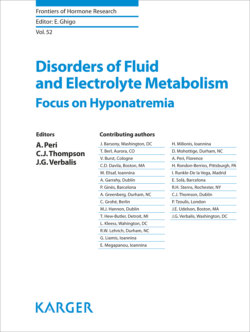Читать книгу Disorders of Fluid and Electrolyte Metabolism - Группа авторов - Страница 48
На сайте Литреса книга снята с продажи.
Hyponatremia in the Emergency Department
ОглавлениеAs depicted above, the majority of hospitalized patients with hyponatremia is already admitted with the disorder. It is therefore interesting to look at the situation in the emergency department. Over a 2-month period in 1996, Lee et al. [39] conducted a prospective observational study on internal medicine patients treated in the emergency department in a large Taiwan hospital. They reported a hyponatremia prevalence (serum [Na+] <134 mEq/L) of 3.8% after correcting for hyperglycemia. In contrast to the markedly lower prevalence found with more profound hyponatremia in unselected inpatient populations, in this analysis mild, moderate ([Na+] 125–129 mEq/L), and severe hyponatremia ([Na+] <125 mEq/L) were present in 36, 32, and 32%, respectively [39]. Hypovolemic states accounted for 65% of all hyponatremia cases while normo- or hypervolemic etiologies were found in approximately 10% each; the remaining 15% were diagnosed with non-hypotonic hyponatremia.
More recently, a similar overall hyponatremia prevalence of 3% was found in a retrospective examination of approximately 200,000 patients visiting the emergency departments of 2 large hospitals in Lund and Malmö (Sweden) [10]. In this survey, however, only 10% of all hyponatremic patients had a plasma [Na+] below 125 mEq/L. With regard to etiology, hypovolemia accounted for approximately 24% (10% due to vomiting or diarrhea, 14% diuretic-induced) of hyponatremia cases while 34% of patients were found to suffer from normonatremic hyponatremia (17% SIADH, 17% thiazide-induced) and 11% from hypervolemic hyponatremia. Alcohol abuse (7%), endocrine disorders, polydipsia, and mixed etiologies accounted for the remaining 31%. In a retrospective cohort study in the emergency department at a teaching hospital in the Netherlands, focusing only on patients over 60 years of age, the prevalence of clinically relevant hyponatremia defined as serum [Na+] <130 mEq/L was 6.3% (4% for [Na+] 125–129 mEq/L and 2.3% for [Na+] <125 mEq/L) [40]. Use of diuretics, hypovolemia, and SIADH were the most frequent etiologies with 27.5, 15.4, and 14.3%, respectively. Huwyler et al. [41] added another interesting finding by showing that the prevalence of profound hyponatremia ([Na+] <125 mEq/L) was higher (1.29%) in summer than in winter (0.54%). Since the proportion of hypovolemic hyponatremia was similar in both summer and winter, it was speculated that an increased water intake in summer might render at-risk patients even more susceptible to developing hyponatremia [41]. This seasonal variation was confirmed by a recent cross-sectional analysis from Italy in which the prevalence for hyponatremia ([Na+] <135 mEq/L) in adult patients of less than 65 years and patients with 65 years or more were 3.6 and 9.4%, respectively, in winter but 4.1 and 12.5% in summer [42].
